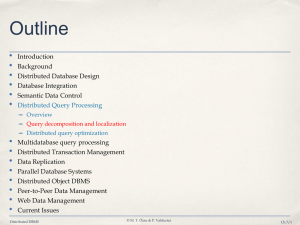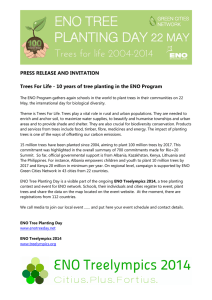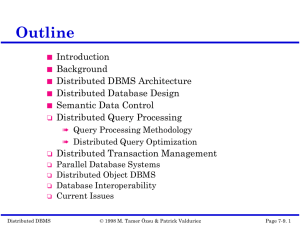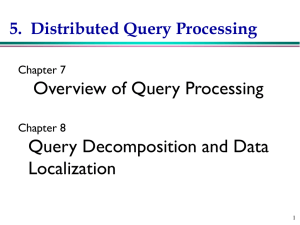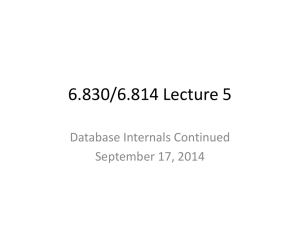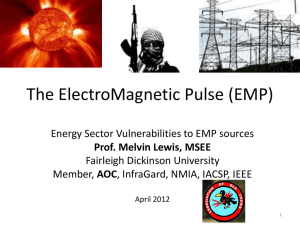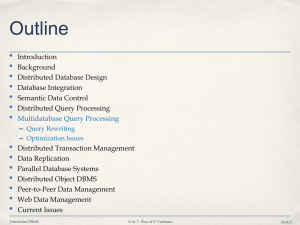7-Query Localizationx
advertisement
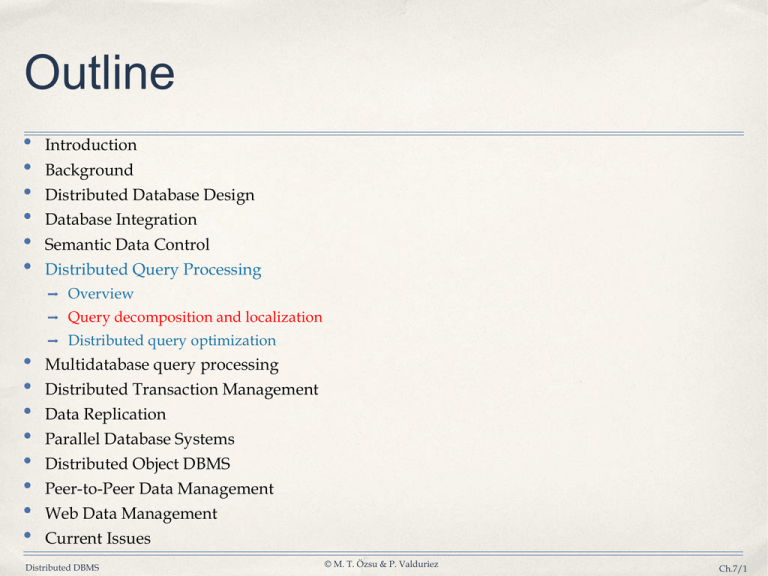
Outline
•
•
•
•
•
•
Introduction
Background
Distributed Database Design
Database Integration
Semantic Data Control
Distributed Query Processing
➡ Overview
➡ Query decomposition and localization
•
•
•
•
•
•
•
•
➡ Distributed query optimization
Multidatabase query processing
Distributed Transaction Management
Data Replication
Parallel Database Systems
Distributed Object DBMS
Peer-to-Peer Data Management
Web Data Management
Current Issues
Distributed DBMS
© M. T. Özsu & P. Valduriez
Ch.7/1
Step 1 – Query Decomposition
Input : Calculus query on global relations
•
•
Normalization
➡ manipulate query quantifiers and qualification
Analysis
➡ detect and reject “incorrect” queries
•
•
➡ possible for only a subset of relational calculus
Simplification
➡ eliminate redundant predicates
Restructuring
➡ calculus query algebraic query
➡ more than one translation is possible
➡ use transformation rules
Distributed DBMS
© M. T. Özsu & P. Valduriez
Ch.7/2
Normalization
•
Lexical and syntactic analysis
➡ check validity (similar to compilers)
➡ check for attributes and relations
➡ type checking on the qualification
•
Put into normal form
➡ Conjunctive normal form
(p11 p12 … p1n) … (pm1 pm2 … pmn)
➡ Disjunctive normal form
(p11 p12 … p1n) … (pm1 pm2 … pmn)
➡ OR's mapped into union
➡ AND's mapped into join or selection
Distributed DBMS
© M. T. Özsu & P. Valduriez
Ch.7/3
Analysis
•
•
Refute incorrect queries
Type incorrect
➡ If any of its attribute or relation names are not defined in the global schema
•
➡ If operations are applied to attributes of the wrong type
Semantically incorrect
➡ Components do not contribute in any way to the generation of the result
➡ Only a subset of relational calculus queries can be tested for correctness
➡ Those that do not contain disjunction and negation
➡ To detect
connection graph (query graph)
✦ join graph
✦
Distributed DBMS
© M. T. Özsu & P. Valduriez
Ch.7/4
Analysis – Example
SELECT
FROM
WHERE
AND
AND
AND
AND
ENAME,RESP
EMP, ASG, PROJ
EMP.ENO = ASG.ENO
ASG.PNO = PROJ.PNO
PNAME = "CAD/CAM"
DUR ≥ 36
TITLE = "Programmer"
Query graph
Join graph
DUR≥36
ASG
ASG.PNO=PROJ.PNO
EMP.ENO=ASG.ENO
TITLE =
“Programmer”
EMP
ENAME
Distributed DBMS
RESP
RESULT
EMP.ENO=ASG.ENO
PROJ
EMP
ASG
ASG.PNO=PROJ.PNO
PROJ
PNAME=“CAD/CAM”
© M. T. Özsu & P. Valduriez
Ch.7/5
Analysis
If the query graph is not connected, the query may be wrong or
use Cartesian product
SELECT
FROM
WHERE
AND
AND
AND
ENAME,RESP
EMP, ASG, PROJ
EMP.ENO = ASG.ENO
PNAME = "CAD/CAM"
DUR > 36
TITLE = "Programmer"
ASG
EMP
ENAME
Distributed DBMS
RESP
RESULT
© M. T. Özsu & P. Valduriez
PROJ
PNAME=“CAD/CAM”
Ch.7/6
Simplification
•
•
Why simplify?
➡ Remember the example
How? Use transformation rules
➡ Elimination of redundancy
✦
idempotency rules
p1 ¬( p1) false
p1 (p1 p2) p1
p1 false p1
…
➡ Application of transitivity
➡ Use of integrity rules
Distributed DBMS
© M. T. Özsu & P. Valduriez
Ch.7/7
Simplification – Example
SELECT
FROM
WHERE
OR
AND
OR
AND
TITLE
EMP
EMP.ENAME = "J. Doe"
(NOT(EMP.TITLE = "Programmer")
(EMP.TITLE = "Programmer"
EMP.TITLE = "Elect. Eng.")
NOT(EMP.TITLE = "Elect. Eng."))
SELECT
FROM
WHERE
Distributed DBMS
TITLE
EMP
EMP.ENAME = "J. Doe"
© M. T. Özsu & P. Valduriez
Ch.7/8
Restructuring
•
•
•
Convert relational calculus to relational
algebra
Make use of query trees
Example
ENAME
Project
σDUR=12 OR DUR=24
Find the names of employees other than
σ
Select
PNAME=“CAD/CAM”
J. Doe who worked on the CAD/CAM
project for either 1 or 2 years.
SELECT ENAME
σENAME≠“J. DOE”
FROM
EMP, ASG, PROJ
WHERE
EMP.ENO = ASG.ENO
⋈PNO
AND
ASG.PNO = PROJ.PNO
AND
ENAME≠ "J. Doe"
⋈ENO
Join
AND
PNAME = "CAD/CAM"
AND
(DUR = 12 OR DUR = 24) PROJ
ASG
EMP
Distributed DBMS
© M. T. Özsu & P. Valduriez
Ch.7/9
Restructuring –Transformation
Rules
•
Commutativity of binary operations
➡R×SS×R
➡ R ⋈S S ⋈R
➡RSSR
•
Associativity of binary operations
➡ ( R × S) × T R × (S × T)
➡ (R ⋈S) ⋈T R ⋈ (S ⋈T)
•
Idempotence of unary operations
➡ A’( A’(R)) A’(R)
➡ p
(
(R))
(A
)
p
(A
)
1 1
2 2
p1(A1)p2(A2)(R)
where R[A] and A' A, A" A and A' A"
•
Commuting selection with projection
Distributed DBMS
© M. T. Özsu & P. Valduriez
Ch.7/10
Restructuring – Transformation
Rules
•
Commuting selection with binary operations
➡ p(A)(R × S) (p(A) (R)) × S
➡ p(A )(R ⋈(A ,B )S) (p(A ) (R)) ⋈(A ,B )S
i
j k
i
j k
➡ p(A )(R T) p(A ) (R) p(A ) (T)
i
i
i
where Ai belongs to R and T
•
Commuting projection with binary operations
➡ C(R × S) A’(R) × B’(S)
➡ C(R ⋈(A ,B )S) A’(R) ⋈(A ,B ) B’(S)
j k
j k
➡ C(R S) C(R) C(S)
where R[A] and S[B]; C = A' B' where A' A, B' B
Distributed DBMS
© M. T. Özsu & P. Valduriez
Ch.7/11
Example
ENAME
Recall the previous example:
Find the names of employees other
than J. Doe who worked on the
CAD/CAM project for either one or
two years.
SELECT ENAME
FROM
DUR=12 DUR=24
PNAME=“CAD/CAM”
Select
ENAME≠“J. DOE”
PROJ, ASG, EMP
WHERE ASG.ENO=EMP.ENO
⋈PNO
AND
ASG.PNO=PROJ.PNO
AND
ENAME ≠ "J. Doe"
AND
PROJ.PNAME="CAD/CAM"
AND
(DUR=12 OR DUR=24)
Distributed DBMS
Project
⋈ENO
PROJ
© M. T. Özsu & P. Valduriez
ASG
Join
EMP
Ch.7/12
Equivalent Query
ENAME
PNAME=“CAD/CAM” (DUR=12 DUR=24) ENAME≠“J. Doe”
⋈PNO,ENO
×
EMP
Distributed DBMS
PROJ
© M. T. Özsu & P. Valduriez
ASG
Ch.7/13
Restructuring
ENAME
⋈PNO
PNO,ENAME
⋈ENO
PNO
PNAME = "CAD/CAM"
PROJ
Distributed DBMS
PNO,ENO
DUR =12DUR=24
ASG
© M. T. Özsu & P. Valduriez
PNO,ENAME
ENAME ≠ "J. Doe"
EMP
Ch.7/14
Step 2 – Data Localization
Input: Algebraic query on distributed relations
•
•
Determine which fragments are involved
Localization program
➡ substitute for each global query its materialization program
➡ optimize
Distributed DBMS
© M. T. Özsu & P. Valduriez
Ch.7/15
Example
ENAME
Assume
➡ EMP is fragmented into EMP1,
EMP3 as follows:
EMP2,
DUR=12 DUR=24
PNAME=“CAD/CAM”
✦
EMP1= ENO≤“E3”(EMP)
✦
EMP2= “E3”<ENO≤“E6”(EMP)
✦
EMP3= ENO≥“E6”(EMP)
ENAME≠“J. DOE”
⋈PNO
➡ ASG fragmented into ASG1 and ASG2
as follows:
✦
ASG1= ENO≤“E3”(ASG)
✦
ASG2= ENO>“E3”(ASG)
⋈ENO
PROJ
Replace EMP by (EMP1 EMP2 EMP3)
and ASG by (ASG1 ASG2) in any query
Distributed DBMS
© M. T. Özsu & P. Valduriez
EMP1EMP2 EMP3 ASG1 ASG2
Ch.7/16
Provides Parallellism
⋈ENO
EMP1
Distributed DBMS
ASG1 EMP2
⋈ENO
⋈ENO
ASG2 EMP3
© M. T. Özsu & P. Valduriez
ASG1 EMP3
⋈ENO
ASG2
Ch.7/17
Eliminates Unnecessary Work
⋈ENO
EMP1
Distributed DBMS
⋈ENO
ASG1 EMP2
ASG2 EMP3
© M. T. Özsu & P. Valduriez
⋈ENO
ASG2
Ch.7/18
Reduction for PHF
•
Reduction with selection
➡ Relation R and FR={R1, R2, …, Rw} where Rj=p (R)
j
pi(Rj)= if x in R: ¬(pi(x) pj(x))
➡ Example
SELECT
FROM
WHERE
*
EMP
ENO="E5"
ENO=“E5”
ENO=“E5”
EMP1
Distributed DBMS
EMP2
EMP3
© M. T. Özsu & P. Valduriez
EMP2
Ch.7/19
Reduction for PHF
•
Reduction with join
➡ Possible if fragmentation is done on join attribute
➡ Distribute join over union
(R1 R2)⋈S (R1⋈S) (R2⋈S)
➡ Given Ri =p (R) and Rj = p (R)
i
j
Ri ⋈Rj = if x in Ri, y in Rj: ¬(pi(x) pj(y))
Distributed DBMS
© M. T. Özsu & P. Valduriez
Ch.7/20
Reduction for PHF
•
⋈ENO
Assume EMP is fragmented as
before and
➡ ASG1: ENO ≤ "E3"(ASG)
➡ ASG2: ENO > "E3"(ASG)
•
Consider the query
EMP1 EMP2 EMP3
SELECT
*
FROM
EMP,ASG
WHERE
EMP.ENO=ASG.ENO
•
•
Distribute join over unions
Apply the reduction rule
⋈ENO
EMP1
Distributed DBMS
© M. T. Özsu & P. Valduriez
ASG1
⋈ENO
ASG1 EMP2
ASG2
⋈ENO
ASG2 EMP3
ASG2
Ch.7/21
Reduction for VF
•
Find useless (not empty) intermediate relations
Relation R defined over attributes A = {A1, ..., An} vertically fragmented
as Ri =A'(R) where A' A:
D,K(Ri) is useless if the set of projection attributes D is not in A'
Example: EMP1=ENO,ENAME (EMP); EMP2=ENO,TITLE (EMP)
SELECT ENAME
FROM
EMP
ENAME
ENAME
⋈ENO
EMP1
Distributed DBMS
EMP2
© M. T. Özsu & P. Valduriez
EMP1
Ch.7/22
Reduction for DHF
•
Rule :
➡ Distribute joins over unions
•
➡ Apply the join reduction for horizontal fragmentation
Example
ASG1: ASG ⋉ENO EMP1
ASG2: ASG ⋉ENO EMP2
EMP1: TITLE=“Programmer” (EMP)
•
EMP2: TITLE=“Programmer” (EMP)
Query
SELECT
*
FROM
EMP, ASG
WHEREASG.ENO = EMP.ENO
AND
EMP.TITLE = "Mech. Eng."
Distributed DBMS
© M. T. Özsu & P. Valduriez
Ch.7/23
Reduction for DHF
⋈ENO
Generic query
TITLE=“Mech. Eng.”
ASG1
ASG2
Selections first
EMP1
⋈ENO
TITLE=“Mech. Eng.”
ASG1
Distributed DBMS
EMP2
ASG2
© M. T. Özsu & P. Valduriez
EMP2
Ch.7/24
Reduction for DHF
Joins over unions
⋈ENO
⋈ENO
TITLE=“Mech. Eng.”
ASG1
EMP2
TITLE=“Mech. Eng.”
ASG2
EMP2
Elimination of the empty intermediate relations
⋈ENO
(left sub-tree)
TITLE=“Mech. Eng.”
ASG2
Distributed DBMS
EMP2
© M. T. Özsu & P. Valduriez
Ch.7/25
Reduction for Hybrid
Fragmentation
•
Combine the rules already specified:
➡ Remove empty relations generated by contradicting selections on horizontal
fragments;
➡ Remove useless relations generated by projections on vertical fragments;
➡ Distribute joins over unions in order to isolate and remove useless joins.
Distributed DBMS
© M. T. Özsu & P. Valduriez
Ch.7/26
Reduction for HF
Example
ENAME
Consider the following hybrid
fragmentation:
ENAME
EMP1= ENO≤"E4" (ENO,ENAME (EMP))
ENO=“E5”
EMP2= ENO>"E4" (ENO,ENAME (EMP))
⋈ENO
EMP3= ENO,TITLE (EMP)
and the query
SELECT ENAME
FROM EMP
WHERE ENO="E5"
Distributed DBMS
ENO=“E5”
EMP2
EMP1 EMP2 EMP3
© M. T. Özsu & P. Valduriez
Ch.7/27

